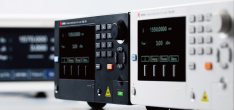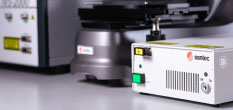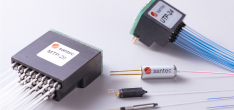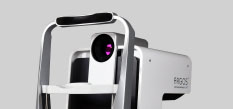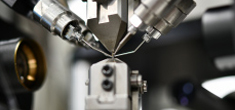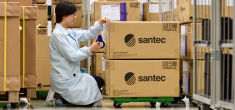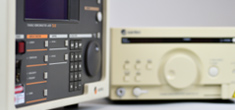Performance and Innovation
Liquid Crystal Technology
What is Liquid crystal?
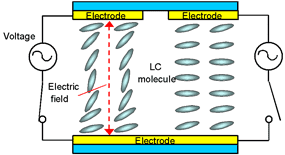
Figure 1. LC device structure
In 1888, Austrian botanist Friedrich Reinitzer discovered that some materials have a middle phase between solid and liquid, and they were called Liquid Crystals. These materials found a wide range of applications from basic scientific research to consumer electronics.
Figure 1 shows LC device structure. Liquid Crystal (LC) molecules are shaped like rods for which each position is random, although the direction of the rods is regularly-arranged parallel to their long axis. The molecules have a dielectric anisotropy and align with the long axis parallel to the direction of applied electric field. Today, this characteristic is utilized as the ON/OFF light switch for displaying an image in LC projectors and displays.
Santec LC technology
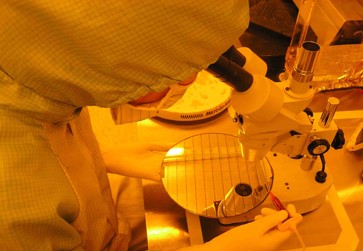
Figure 2. LC device assembling process
Santec has developed and manufactured LC devices as one of our core technologies for advanced optical devices and systems, as shown in Figure 2. The mass production line consists of an 8 inch wafer process. Santec LC devices are characterized by a wide viewing angle, high contrast ratio and high reliability resulting from adopting vertically aligned nematic (VA) mode and inorganic LC alignment layer.
LCOS spatial light modulator
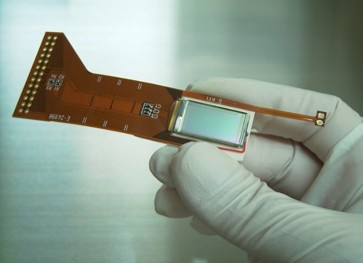
Figure 3. Example of LCOS device
LCOS is a micro-display and micro-projection technology for LC projectors and rear-projection TVs. LCOS is a normally reflective type LC panel consisting of reflective layers and LC on Si substrate. Figure 3 shows an example of a LCOS device. Switching elements and electric wires for driving LC are integrated on Si substrate under the reflective layer with semiconductor manufacturing technology and the image is characterized by seamless and high pixel resolution.
We have developed an unique LCOS device for a variety of applications including fiber-optics using proprietary LC materials.
LCOS performance (phase modulation scheme)
1. Phase shift (φ)
Maximum phase shift of 2π rad at 1550 nm is available. Figure 4 shows tphase performances in (a)π rad and (b)2π rad in a user setting. Users can choose π rad mode or 2π rad phase shift mode by adjusting the drive parameters. Santec’s high resolution LCOS device shows an excellent phase linearity without a LUT (look-up-table) option on the driver board. LUT is also available as an option.

(b)
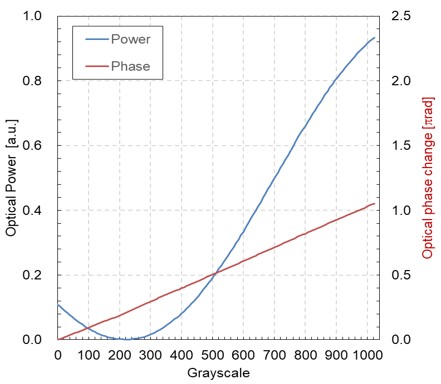
(a)
2. Response time (τ)
Our LCOS device shows typical τ = 236ms in fall-down time (90 % - 10 %) as shown in Figure 5.
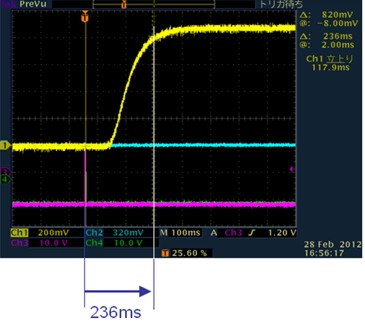
Figure 5. LCOS device response characteristics
3. Phase stability (Flicker noise)
In general, a phase noise at a video frame rate is generated in a LCOS device. This noise is called as Flicker noise. Figure 6 shows an example of phase stability. Our LCOS device has been designed to minimize the Flicker noise as as possible for fiber-optic and precision applications. Our LCOS device has achieved phase stability as small as 0.002 πrad, as shown in Figure 6 red line.

Figure 6. A comparison of phase stability between Santec (in red line) and Competitor A (in blue line)
LC device for fiber-optics
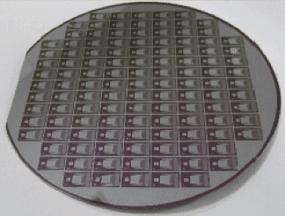
Figure 7. 6 inch LC device wafer
A change of LC dielectric constant anisotropy along with applied electric field enables the control of optical phase and amplitude freely. Santec has developed various optical components and test instruments utilizing the LC controllability for advanced optical communication networks. Santec LC devices are Telcordia qualified and high reliability is guaranteed in our components and instruments (Figure 7).
The wavelength blocker (WB) is a multi-functional optical module for constructing ROADM (Reconfigurable Optical Add/Drop Multiplexer) nodes in next generation optical networks (Figure 8). The module outputs WDM (Wavelength Division Multiplexing) signals with an arbitrary amplitude or blocking for any WDM channels. Santec WB adopts reflective type LC devices with segment electrodes corresponding to WDM channel number for optical amplitude control.
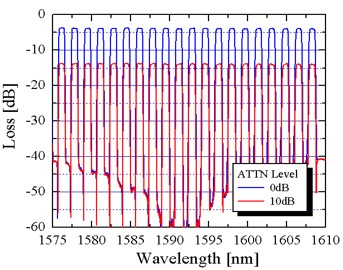
(c)
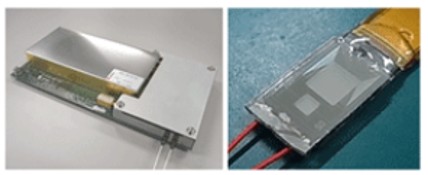
(a) (b)
Spectrum controllable tunable filters with LCOS technology enables an arbitrary optical spectrum. The filter allows you to design any complex optical filters for next generation optical communication networks, which were difficult to realize with conventional filter technologies.
Figure 9 shows arbitrary spectra. The pixel pitch, width and number of LCOS chip are 5 μm, 4.7 μm and 2560 μm, respectively. And 12 bit level of LC driving voltage makes high spectrum control resolution possible.
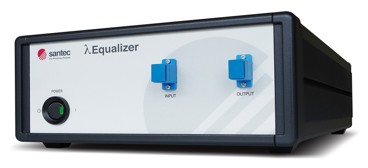
(b)
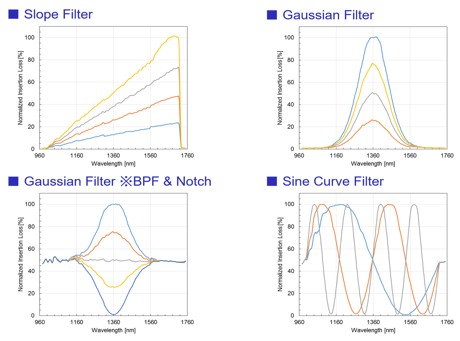 (a)
(a)Figure 9. Arbitrary spectral filter (a) arbitrary shape spectra, (b) product outlook( λEqualizer)
